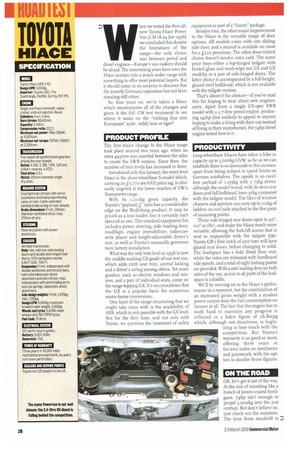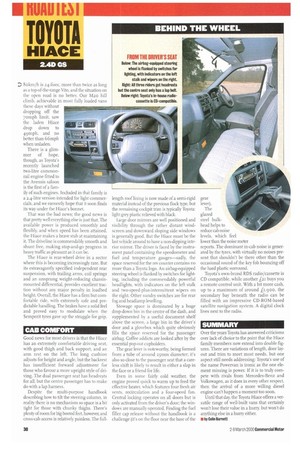TOYOTA HlACE 2.4D GS
Page 28

Page 30

Page 32

If you've noticed an error in this article please click here to report it so we can fix it.
'PRICE AS TESTED: £14,047 (ex-VAT), includes £13,835 for basic vehicle and £212 for metallic paint. ENGINE: 2.4 litres, 74hp (55kW). GVW: 3,000kg. PAYLOAD: 1,235kg. FUEL CONSUMPTION (laden): 26.7mpg (10.511t/100km). hen we tested the then allnew Toyota Hiace Power Van (CM 18-24 Jan r996) we concluded that despite the limitations of the range—the only choice was between petrol and diesel engines—Europe's van makers should be afraid. The intervening years have seen the Hiace mature into a much wider range with something to offer most potential buyers. But it should come as no surprise to discover that the (mostly German) opposition has not been standing still either.
So, four years on, we've taken a Hiace which encompasses all of the changes and given it the full CM test treatment to see where it ranks on the "striking fear into Europeans" scale...teddy bear or tiger?
PRODUCT PROFILE
The first major change to the Hiace range took place around two years ago, when an extra 445mm was inserted between the axles to create the LWB version. Since then, the number of trim levels has increased to three.
Introduced only this January, the entry level Hiace is the short-wheelbase S-model which, carrying an L11,770 (ex-VAT) price tag, is obviously targeted at the lower reaches of VW's Transporter range.
With its 1,210kg gross capacity, the Toyota's "payload/f' ratio has a considerable edge on the Wolfsburg product. It may be priced as a loss-leader, but it certainly isn't specced as one. The standard equipment list includes power steering, side loading door, mudflaps, engine immobiliser, radio-cassette player and height-adjustable driver's seat, as well as Toyota's unusually generous twin battery installation.
What was the only trim level in 1996 is now the middle ranking GS grade of our test van, which adds cloth seat trim, central locking and a driver's airbag among others. Yet more goodies, such as electric windows and mirrors, and a pair of individual seats, come on the range-topping GX. It's no coincidence that the GX is a popular basis for numerous motor-home conversions.
One facet of the range structuring that we might take issue with is the availability of ABS, which is only possible with the GX level. Not for the first time, and not only with Toyota, we question the treatment of safety
equipment as part of a luxury" package.
Besides trim, the other major improvement to the Hiace is the versatile range of door options. All models come with one sliding side door, and a second is available on most for a Lazo premium. The other door-related choice doesn't involve extra cash. The same price buys either a top-hinged tailgate with heated glass and wash-wipe (on GS and GX models) or a pair of side-hinged doors. The latter choice is accompanied by a full-height, glazed steel bulkhead, which is not available with the tailgate version.
That's about it for choices—if you've read this far hoping to hear about new engines, sorry. Apart from a single GX-spec SWB model with a 2.7-litre petrol engine, producing 141hp (but unlikely to appeal to anyone hoping to make a living with their van instead of living in their motorhome), the 74hp diesel engine tested here is it.
PRODUCTIVITY
Long-wheelbase Hiaces have taken a hike in capacity up to 3,00okg GVATV; as far as we can establish there is no downside to this increase apart from being subject to speed limits on German autobahns. The upside is an excellent payload of 1,235kg with a 75kg driver, although the model tested, with its twin-rear doors and full bulkhead, loses 3okg compared with the tailgate model. The likes of window cleaners and painters can carry up to ilokg of ladders on roof rails attached to the five pairs of mounting points.
Those side-hinged rear doors open to 900, Ho° or 18o*, and make the Hiace much more versatile, allowing the fork-lift access that is next to impossible with the tailgate type. Toyota GB's first batch of 3oo vans will have glazed rear doors, before changing to solid. The loadspace has a fully fitted floor mat, while the sides are trimmed with hardboard side panels, and a total of eight lashing points are provided. With a side loading door on both sides of the van, access to all parts of the loadspace is a doddle.
We'll be moving on to the Hiace's performance in a moment, but the combination of an increased gross weight with a modest power output does the fuel consumption no favours at all. The fact that the engine has to work hard to maintain any progress is reflected in a laden figure of 26 .8mpg which, although not disastrous, is beginning to lose touch with the competition. But Toyota's warranty is as good as most, offering three years or 6o,000 miles on mechanics and paintwork, with the option to double those figures.
ON THE ROAD
OK, let's get it out of the way. At the risk of sounding like a bunch of power-crazed hooligans, 74hp isn't enough to propel 3,000kg into the zist century. But don't believe us, just check out the numbers. The time from standstill to Sok mill is 24.6sec, more than twice as long as a top-of-the-range Vito, and the situation on the open road is no better. Our M20 hilt climb, achievable in most fully loaded vans these days without dropping off the 7omph limit, saw the laden Hiace drop down to 49mph, and no better than 66mph when unladen.
There is a glimmer of hope, though, as Toyota's recently launched two-litre commonrail engine fitted to the Avensis saloon is the first of a family of such engines. Included in that family is a 2.4-litre version intended for light commercials, and we earnestly hope that it soon finds its way under the Hiace's bonnet.
That was the bad news; the good news is that pretty well everything else is just that. The available power is produced smoothly and flexibly, and when speed has been attained, the I liace makes a brave stab at maintaining it. The driveline is commendably smooth and shunt free, making stop-and-go progress in heavy traffic as pleasant as it can be.
The Hiace is rear-wheel drive in a sector where this is becoming increasingly rare. But its extravagantly specified independent rear suspension, with trailing arms, coil springs and an unsprung weight-reducing chassismounted differential, provides excellent traction without any major penalty in loadbed height. Overall, the Hiace has a firm but comfortable ride, with extremely safe and predictable handling. The brakes have a solid feel and proved easy to modulate when the Semperit tyres gave tip the struggle for grip.
CAB COMFORT
Good news for most drivers is that the Iliace has an extremely comfortable driving seat, with good thigh and back support, and an arm rest on the left. The long cushion adjusts for height and angle, but the backrest has insufficient forward adjustment for those who favour a more upright style (>1(16v-ing. The dual passenger seat has headrests for all, but the centre passenger has to make do with a lap harness.
Despite the multi-purpose handbook describing how to tilt the steering column, in reality there is no mechanism so space is a bit tight for those with chunky thighs. There's plenty of room for big booted feet, however, and cross-cab access is relatively painless. The full length roollining is now made of a semi-rigid material instead of the previous flock type, but the remaining cockpit trim is typically Toyota: light grey plastic relieved with black.
Large door mirrors are well positioned and visibility through the rather distant windscreen and downward sloping side windows is generally good. But the Hi ace must be the last vehicle around to have a non-dipping interior mirror. The driver is faced by the instrument panel containing the speedometer and fuel and temperature gauges—sadly, the space reserved for the rev counter contains no more than a Toyota logo. An airbag-equipped steering wheel is flanked by switches for lighting, including the commendably powerful headlights, with indicators on the left stalk and two-speed-plus-intermittent wipers on the right. Other sundry switches are for rear fog and headlamp levelling.
Stowage space is dominated by a huge drop-down bin in the centre of the dash, and supplemented by a useful document shelf above the screen, a large bin in the driver's door and a glovebox which quite obviously fills the space reserved for the passenger airbag. Coffee addicts are looked after by the essential pop-out cupholders.
The gear lever is noteworthy, being formed from a tube of around 25mrn diameter; it's also so close to the passenger seat that a careless shift is likely to result in either a slap in the face or a friend for life.
Even in some fairly cold weather, the engine proved quick to warm up to feed the effective heater, which features four fresh air vents, recirculation and a four-speed fan. Central locking operates on all doors but is only activated from the driver's door; the windows are manually operated. Finding the fuel filler cap release without the handbook is a challenge (it's on the floor near the base of the gear lever).
The glazed steel bulkhead helps to reduce cab noise levels, which feel lower than the noise meter reports. The dominant in-cab noise is generated by the tyres, with virtually no noises present that shouldn't be there other than the occasional sound of the key fob bouncing off the hard plastic surround.
Toyota's own-brand RDS radio/cassette is CD compatible, while another £21 buys you a remote control unit. With a bit more cash, up to a maximum of around £1,900, the secondary bay beneath the radio can be filled with an impressive CD-ROM-based satellite navigation system. A digital clock lives next to the radio.
SUMMARY
Over the years Toyota has answered criticisms over lack of choice to the point that the lliace family members now extend into double figures. There are variations of length. door layout and trim to meet most needs, but one aspect still needs addressing: Toyota's use of the name Powervan is ironic as the one element missing is power. If it is to truly cornpete with rivals from Mercedes-Benz and Volkswagen, as it does in every other respect, then the arrival of a more willing diesel engine can't happen a moment too soon.
Until that day, the Toyota Hiace offers a versatile range of well-built vans that certainly won't lose their value in a hurry. but won't do anything else in a hurry either.
• by Cohn Barnett








































































































